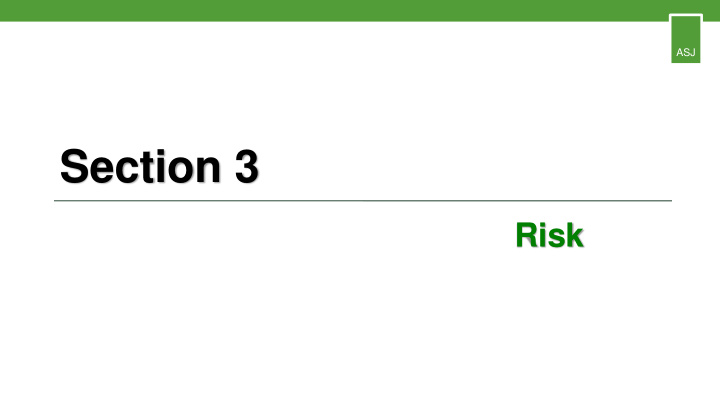



ASJ Section 3 Risk
ASJ Stages of an Audit
Audit Approaches ASJ • In this approach, audit resources are targeted on testing large volumes of transactions and account balances without any particular focus on specified Substantive areas of the financial statements. Approach • This approach requires auditors to assess the effectiveness of the internal controls of an entity, and then to direct substantive procedures. System Based Approach • In this approach, audit resources are directed towards those areas of the financial statements that may contain misstatements as a Risk Based consequence of the risks faced by the business. Approach
Understanding the Entity’s Business ASJ The auditor is required to identify and assess the risks of misstatement through understanding the entity and its environment, including its internal controls. This will involve considering such factors as: • Industry and regulatory factors • Applicable financial reporting framework. • The nature of the entity, its operations, ownership, management structures • Types of current and planned investments • The entity’s selection and application of accounting policies and their consistency • The entity’s objectives and strategies • Business risks that may result in risks of material misstatement. • The measurement and review of the entity’s financial performance.
K O B & Its Sources ASJ KOB is the key to assessing risk. Activities Management Systems Controls My client Accounting policies Information Risks from: Me and my Auditors team need to know (discussion and about: experience) Industry Competition Technology My firm Laws and regulations Firm’s procedures / Stakeholders My Knowledge sharing Financing client’s Trading partners environment Related parties Disposals acquisitions
Link between business risk, risk of material misstatement & audit risk ASJ Audit risk is simply that auditor expresses an inappropriate opinion on financial statements whereas business risks and risk of material misstatement relate to the entity and Business risk is the risk occurring that could affect an entity’s ability to achieve its objectives. Although audit risks and business risks are dissimilar in nature, it is often the case that identification of significant business risks lead to the audit risks as we can see in the following example: Risk of material misstatement is a risk that financial statement may contain the material misstatement. Example Matter The Board of Director of a company accepted the proposal of the Finance Director to sell off a low performing subsidiary of the Company after two year. Business Risk The full worth of the subsidiary may not be realized by the company through the sale transaction. Risk of material misstatement Financial results of the subsidiary might be manipulated to influence the market value of its shares prior to the sale transaction. Audit Risk Auditor fails to report the effect of manipulated Financial results of the subsidiary in his audit report.
Components of Risk ASJ Entity / RMM Auditor
ASJ Audit Risk Explained
ASJ
ASJ
ASJ
ASJ
Components of Audit Risk ASJ Audit risk (AR) Audit risk Definition The risk of issuing the wrong audit opinion Inherent risk (IR) Control risk (CR) Detection risk (DR) The risk of errors or The risk of error or The risk that the auditor’s misstatements because misstatement due to procedures do not pick up the company’s internal the nature of the material misstatements. controls are not strong company and its Enough to prevent, detect and transactions correct them. Example Example Example Higher risk: Higher risk: • A client in a volatile industry. Higher risk: • Lack of IT controls • Using inappropriate • At account balance level • Poor controls over high value procedures - high value, easily stolen Stock • Misinterpreting results. stock • Lack of authorization controls . • At transaction level - complex transactions involving foreign currency.
Ways of reducing entity’s risks ASJ WAYS OF REDUCING RISK Abandoning Internal Improving risky control staff activities procedures training Insurance Implementing better coverage to mitigate loss procedures
RMM at financial statements as well as assertion level ASJ At Financial Statement Level: Risks at financial statement level are those which are pervasive (vast) to the financial statements as a whole and which potentially affect many assertions. At Assertion Level: Risk at assertion level are those which relate to specific objectives of the financial statements. Assertion Dictionary meaning - A confident statement of the fact or belief. ISAs definition – Representations (formal statements) by management, that are embodied (included) in the financial statements, as used by the auditor to consider the different type of potential misstatements that may occur. ISAs definition simplified – Claims by management regarding the appropriateness of the various elements of financial statements and disclosures.
Quick Revision – Topics Covered ASJ 1. Audit approaches 2. Understanding the entity, its environment including its internal controls 3. KOB and its sources 4. Components of Audit Risk – IR, CR, and DR 5. Ways of reducing entity’s risks 6. RMM at financial statements as well as assertion level 7. Practiced 1 TBQ 4 SBQs
Recommend
More recommend